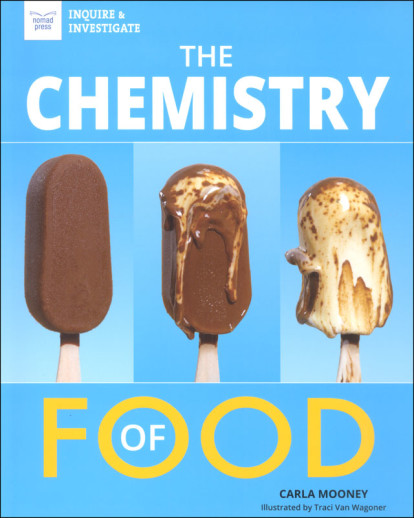We use cookies to make your experience better. To comply with the new e-Privacy directive, we need to ask for your consent to set the cookies. Learn more.
Chemistry of Food
What a fun way to get kids excited about chemistry! This book is full of projects, recipes, and colorful pictures to show firsthand how chemistry is found everywhere in the kitchen. An introduction covers some chemistry basics and then the five chapters cover: chemicals in our food, cooking as a chemical reaction, nutrition, flavors, and texture. Each chapter begins with text information to read, along with quick facts, diagrams, photos, or QR codes for videos and demonstrations. Each chapter ends with several "Inquire and Investigate" experiments to complete to explore the topic. For example, in the chapter on cooking as a chemical reaction, students will carmelize sugar, carmelize carrots, make lemon curd, bake cookies at different temperatures and more. This could be used as a nice primer into the world of chemistry for younger kids, or as an engaging chemistry supplement for older teens. Beginning pages provide a helpful chemistry timeline and a bright, double-page spread with the periodic table of elements. 128 pgs, pb. ~Nancie
A fun way for middle schoolers to learn about chemistry... through food! Includes hands-on science projects and graphic novel type illustrations.
Why does tomato sauce taste different from fresh tomatoes? Why does pasta go limp when you cook it in boiling water? What makes ice cream melt?
In The Chemistry of Food, middle school readers learn the science behind the food they love to eat as they explore the chemistry within the meal, how nutrition works, what creates flavor, and why texture is important. What better place to learn the fundamentals of chemistry than in the kitchen? This book offers detailed explanations of five ways chemistry is part of the food they eat. Hands-on, science-minded investigations, links to online resources and media, career connections, and text-to-world questions all create a delicious learning experience for ages 12 to 15. Plus recipes!
Homeschool Chemistry Curriculum, Workbooks, Lab Materials, Kits, Games, and Chemistry Lab Supplies
| Product Format: | Paperback |
|---|---|
| Brand: | Nomad Press |
| Grades: | 7-10 |
| ISBN: | 9781647410261 |
| Length in Inches: | 10 |
| Width in Inches: | 8 |
| Height in Inches: | 0.25 |
| Weight in Pounds: | 0.7 |

